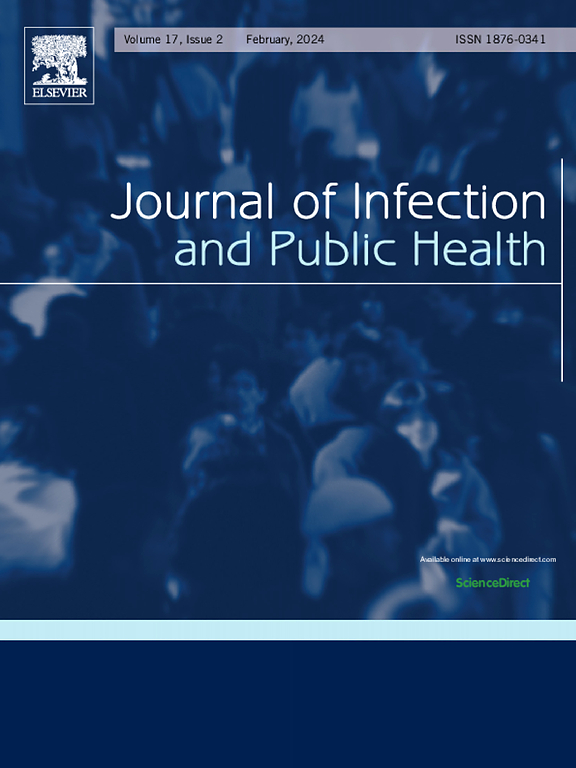MRSA中mecA和mecC基因的全球流行和动态:meta- meta分析,meta-回归和时间调查
IF 4
3区 医学
Q1 INFECTIOUS DISEASES
引用次数: 0
摘要
本研究旨在对mecC和meca阳性MRSA菌株进行首次meta-meta分析,确定其总体患病率和时间趋势。它包括14项荟萃分析,涉及来自553项指数研究的322,269个样本。MRSA菌株的mecA / mecC阳性范围为0.90 % ~ 69.98 %。观察到不同的AMSTAR和QUOROM评分。mecc阳性MRSA患病率为2.41 %(95 % CI: 0.72-7.78 %)。人类mecA-positive耐甲氧西林金黄色葡萄球菌21.77 %患病率(95 %置信区间:9.08—-43.67 %),动物样本有7.08 %患病率(95 %置信区间:3.93—-12.42 %),和全球患病率为14.58 %(95 %置信区间:6.61—-29.14 %)。时间趋势显示出波动,2012年mecA患病率飙升至52.68 %,2022年降至7.11 %。对于mecC基因,2015年的发病率较低,为0.41 %(95 % CI: 0.05-3.54 %)。总的来说,在MRSA菌株中,尤其是在人类中,mecA基因携带量超过了mecC。本文章由计算机程序翻译,如有差异,请以英文原文为准。
Global prevalence and dynamics of mecA and mecC genes in MRSA: Meta-meta-analysis, meta-regression, and temporal investigation
This study aimed to conduct first robust meta-meta-analysis on mecC and mecA-positive MRSA strains, determining their overall prevalence and temporal trends. It encompassed 14 meta-analyses, involving 322,269 samples from 553 index studies. MRSA strains exhibited mecA / mecC positivity ranging from 0.90 % to 69.98 %. Varied AMSTAR and QUOROM scores were observed. mecC-positive MRSA prevalence was 2.41 % (95 % CI: 0.72–7.78 %). Human mecA-positive MRSA had 21.77 % prevalence (95 % CI: 9.08–43.67 %), animal samples had 7.08 % prevalence (95 % CI: 3.93–12.42 %), and worldwide prevalence was 14.58 % (95 % CI: 6.61–29.14 %). Temporal trends reveal fluctuations, mecA prevalence spiked to 52.68 % in 2012 and decreased to 7.11 % in 2022. For mecC gene, the year 2015 marked a low incidence of 0.41 % (95 % CI: 0.05–3.54 %). Overall, mecA gene carriage surpassed mecC in MRSA strains, especially in humans.
求助全文
通过发布文献求助,成功后即可免费获取论文全文。
去求助
来源期刊

Journal of Infection and Public Health
PUBLIC, ENVIRONMENTAL & OCCUPATIONAL HEALTH -INFECTIOUS DISEASES
CiteScore
13.10
自引率
1.50%
发文量
203
审稿时长
96 days
期刊介绍:
The Journal of Infection and Public Health, first official journal of the Saudi Arabian Ministry of National Guard Health Affairs, King Saud Bin Abdulaziz University for Health Sciences and the Saudi Association for Public Health, aims to be the foremost scientific, peer-reviewed journal encompassing infection prevention and control, microbiology, infectious diseases, public health and the application of healthcare epidemiology to the evaluation of health outcomes. The point of view of the journal is that infection and public health are closely intertwined and that advances in one area will have positive consequences on the other.
The journal will be useful to all health professionals who are partners in the management of patients with communicable diseases, keeping them up to date. The journal is proud to have an international and diverse editorial board that will assist and facilitate the publication of articles that reflect a global view on infection control and public health, as well as emphasizing our focus on supporting the needs of public health practitioners.
It is our aim to improve healthcare by reducing risk of infection and related adverse outcomes by critical review, selection, and dissemination of new and relevant information in the field of infection control, public health and infectious diseases in all healthcare settings and the community.
 求助内容:
求助内容: 应助结果提醒方式:
应助结果提醒方式:


